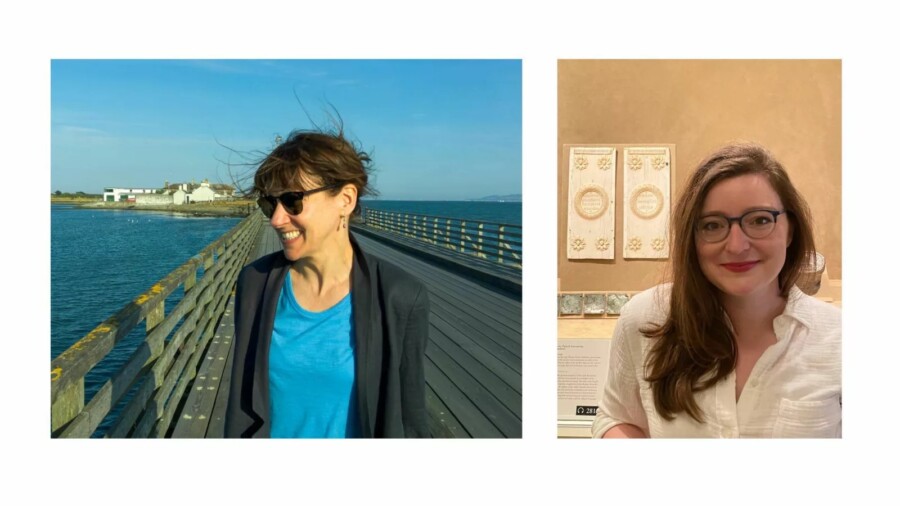European Art Seminar
@ Newberry Library
60 W Walton St, Chicago, IL 60610
Opening Friday, June 9th, from 6PM - 4PM
Margaret MacNamidhe, School of the Art Institute of Chicago & Nicole Pulichene, University of Wisconsin-Madison
Register
European Art Seminar
Jun 09, 2023
2:00pm–4:00pm
At the Newberry – ITW Seminar Room
“Dispatch” Through a “Peculiar” Movement of the Pen: Joseph Carstairs at the Newberry Library
‘Write in Your Heart like Children Learning their ABCs’: Educational Writing Tablets from Antiquity to the Present
“Dispatch” Through a “Peculiar” Movement of the Pen: Joseph Carstairs at the Newberry Library
Margaret MacNamidhe, School of the Art Institute Chicago
Many of Joseph Carstairs’s (1783-1844) manuals are in the collection of the Newbery Library; A New System of Teaching the Art of Writing (1814) and National System of Penmanship (1843) are examples. They are often cited as the most important antecedent for Spencerian writing—that florid hand which dominated the US in the mid to late 19th century. Carstairs’s own swooping movements and intense concentration on speed—the “running hand”—require their own terms of explanation. Kinaesthetic knowledge is what this method of learning has been called; scholarly discussion—Zeynep Çelik Alexander, Tamara Plakins Thornton—has shed light on how a belief in the kinaesthetic body underwrote educational reforms that took hold in the US as well as in Europe from the 1870s onward. In art and design education, such developments—including the 1880s revival of the Swiss childhood pedagogue Johann Heinrich Pestalozzi (1746-1827)—are seen to flow directly into the famously embodied approach to instruction pursued at the Bauhaus. Examination of Carstairs’s manuals reveal that his stringent requirements that the arm move in sharply vertical directions were not pressed into the service of any holistically tactile or sensorial program—his program needed to retain tight ties to the “Counting-House” in the realm of commerce. Nonetheless, Carstairs remained conscious of attempts to deliver education to greater and greater numbers of pupils while his system reflected early nineteenth-century changes to John Locke’s (1632-1704) highly influential recommendations about a child’s optimal upbringing.
‘Write in Your Heart like Children Learning their ABCs’: Educational Writing Tablets from Antiquity to the Present
Nicole Pulichene, University of Wisconsin-Madison
Best known today for the Vulgate translation of the Bible, one of three translations he prepared, the Roman theologian Jerome (ca. 347–420 C.E.) anticipated an important step in the pursuit of biblical knowledge – literacy – by designing an elaborate home-schooling program for a young child named Paula. Through hands-on writing exercises committed to wax tablets, Jerome’s letter to Paula’s mother Laeta ultimately outlines his ideal for the spiritual growth of Christians: “Write in your heart like children learning their ABCs, carving the curved letters with trembling hand in the tablet, and learning by concentration to write correctly.” For young Christians like Paula, Jerome’s description of the heart as a writing tablet would have also brought to mind the Hebrew Tablets of the Law that, according to the Book of Exodus, were inscribed in stone by God and, according to the Book of Proverbs, internalized by devotees in the “fleshly tables of the heart.”
Throughout the Roman world, archaeological examples of wax writing tablets demonstrate the ubiquity of this medium in the education of children. Even the martyrdom of the school teacher Cassian, as recounted in Prudentius’ Crown of Martyrdom (Peristephanon), draws from his murderous students’ experience of the fourth-century Roman classroom. As counterexamples to Christians behavior, these children made weapons of their writing styli, the double-sided metal instruments that, on the pointed side, incised the wax or, on the flat side, smoothed out unwanted inscriptions. Words committed to wax surfaces, therefore, could either be interpreted as uniquely truthful or highly susceptible to corruption. Because of their malleability, wax tablets were also effective models for ars memoriae, the art of training the mind to retain and impose order upon information in order to improve recollection and sharpen rhetorical skills. In this seminar, Paula’s educational program serves as a jumping-off point for assessing the role of writing tablets in the development of literacy and Christian identity in Mediterranean contact regions. Drawing from late antique, medieval, and early modern sources housed in the Newberry Library, this session invites participants to discuss the manual and haptic aspects of writing in late antiquity and to identify points of intersection between premodern writing technologies and modern alternatives
Registration
This event is free, but all participants must register in advance. Space is limited, so please do not request a paper unless you plan to attend.
Register and Request Papers
https://reg.learningstream.com/reg/event_page.aspx?ek=0057-0014-b04050473dfc4e78bef8f5e472fdf633
About the European Art Seminar
The Center for Renaissance Studies European Art Seminar considers work in art history that explores painting, sculpture, graphic art, architecture, caricature, manuscript illumination, book arts, and material culture.
The coordinators for the Seminar in European Art are Suzanne Karr Schmidt (Newberry Library), Lia Markey (Newberry Library), and Walter Melion (Emory University).
The European Art Seminar is sponsored by the Samuel H. Kress Foundation.
Official Website
More events on this date
Tags: Chicago, European Art Seminar, Margaret MacNamidhe, Near Norths Side, Newberry Library, Nicole Pulichene, School of the Art Institute of Chicago & Nicole Pulichene, University of Wisconsin Madison

« previous event
next event »